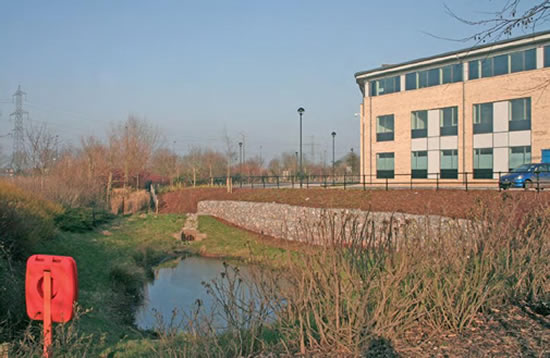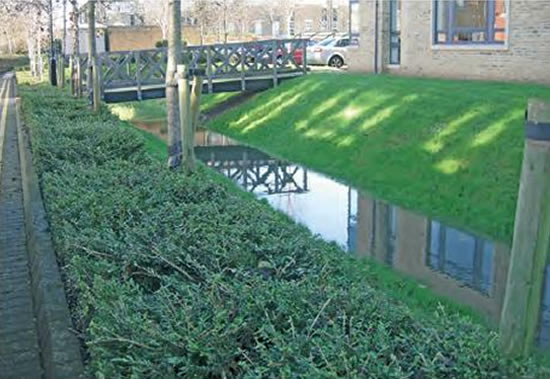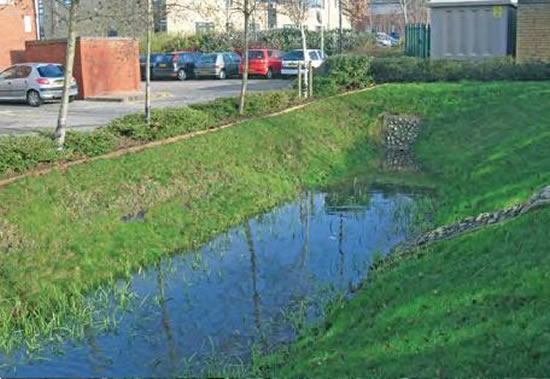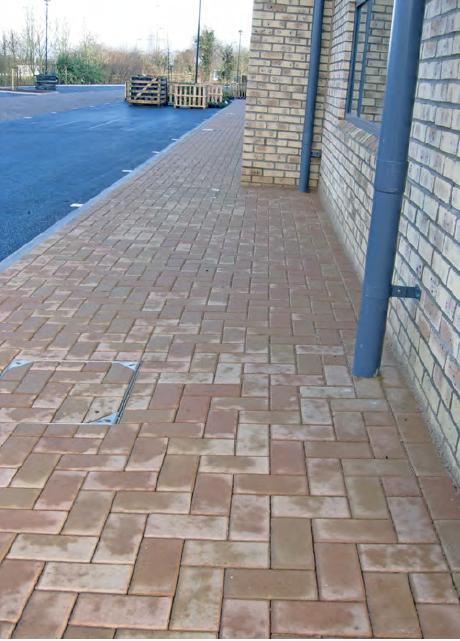Where
Location
8 Priory Road Bristol BS8 1PYMain SuDS used
A blue roof has been used to provide storage volume for attenuating storm events. This was fitted with a greenroof to reduce the rate of surface water runoff. Although not pursued here, blue roofs can also be combined with recreational areas and could be integrated into a rainwater harvesting system to provide a water resource.
How it works
The surface water drainage was a significant constraint, with the need to discharge to a combined sewer with limited capacity. The solution makes use of the flat roof of the building to reduce the need for other attenuation methods.
Design and construction
The site is a confined, former garden area located between buildings. The flat roof of the auditorium used a concrete structural deck. This was overlain with an isolating membrane, insulating layer and waterproofing membrane. Two 50mm deep plastic crate layers were installed on top of a protective mat, to provide the required attenuation. A filter sheet was fitted to prevent sediment ingress. The soil and drainage matrix and seeded planting media of a traditional green roof were fitted on top.The blue roof drains through outlets with the discharge controlled by flow restrictors that are fitted into a standard orifice.
An overflow system was fitted for events in excess of this or for rainfall events where the system had not fully drained. These overflows were vertical pipes that bypassed the blue roof to discharge storm waters directly off the roof.

Benefits and achievements
-
Enables development of constrained sites as requires minimal loss of land.
-
Green roof reduces surface water runoff rate.
-
Blue roof provides surface water runoff storage volume.
-
Ecological and water quality improvements.
Challenges
Structural Loadings: Whilst the additional loading of water on the structure is an obvious consideration, standard UK roof designs do already account for dead loads that include a minimal allowance of 0.6kN/sq m (such as might result from a snow load). As a guide for the UK, the load saving of a standard roof from the snow loading alone could equate to an equivalent water depth of 0.06m, which if contained over a building with a flat roof area of 500m2 equates to an attenuation volume of 30m3.
Additionally, blue roof designs do not require an overlying screed layer to be added, resulting in a typical weight reduction of between 1.2kN/m2 and 4.8kN/m2 (UK data).
The waterproofing of the flat roof is a key consideration. A high performance roof membrane was used that is dual reinforced, fully bonded and with a mineral free surface. With the correctly specified and installed materials, the blue roof has a 50-year warranty although it is anticipated to last considerably longer. The membranes is protected from some causes of degradation (e.g. UV exposure, falling debris).
Maintenance
Overlying the blue roof, the green roof is fitted with filter layers, with this limiting any additional maintenance over a traditional green roof for the upkeep of a blue roof. The orifice outlets from the blue roof are fitted with a grated cover allowing observations to be made and can be easily accessed from the top surface for maintenance. The flow restrictor that fits into the orifice plate can also be removed from the top surface to allow water to drain from the flat roof and for maintenance, if necessary. The modular design of the blue roof and green roof also allow it to be disassembled reasonably easily if so required.
Team and details
WSP were appointed by Sweett Group on behalf of the University of Bristol for the structural and drainage design of the auditorium.
The blue roof was supplied and fitted by Alumasc / Harmer and the green roof was supplied and fitted by Blackedown.



